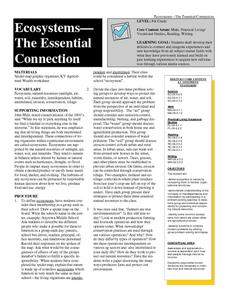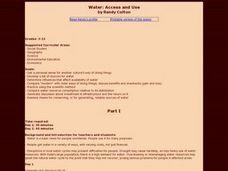Curated OER
Civil liberties: Other freedoms
Students expore civil liberties. They identify and define legal rights. Students consider the impact of applying rights in criminal matters. They identify Canadians' political rights and suggest why they are essential to a democracy....
Curated OER
"Open Mic" - Giving Creative Expression To The Connection Between The Japanese American Internment, September 11, And Our Rights Today
Young scholars explore the similarities of the Japanese-American experience in WWII and Arab-American experience in post-September 11 US policy. They create presentations on their reflections and express themselves through poetry, dance,...
Advocates for Human Rights
All about Me!
Celebrate the uniqueness of your students with this character building lesson plan series. In order to learn about and appreciate diversity and individuality, children create All About Me books by cutting out and drawing pictures that...
University of Minnesota
Sheep Brain Dissection
Bored with frog and earthworm dissections? Had your fill of fetal pigs? Anatomy students will be intrigued by the sheep's brain, and you will be prepared with guiding questions, extension activities, and pictures as they dissect one —...
Curated OER
Home in the Desert: Lesson for Use with This House is Made of Mud
Third graders examine how a family modifies their environment to create a home out of mud. They read the book "This House is Made of Mud" by Ken Buchanan, and write a description of their own home that compares the home of mud to their...
Curated OER
The Water We Drink
Third graders relate that the quality of their drinking water is subject to the condition of the environment and water found in streams and creeks in their community. They track the travel of a wad of paper from a student's desk to a...
Curated OER
Living in the Desert
Conduct an investigation on the plants used by the Hohokam tribe. To survive in the harsh desert environment the Hohokam used many natural resources. Learners read, research, map, and graph multiple aspects of Hohokam plant use as a...
Curated OER
Ecosystems-The Essential Connection
Students develop their abilities to solve problems both in school and in a variety of situations similar to that they have encountered in life. They define the term ecosystem in nature by comparing them to familiar organizational...
Curated OER
Travelogs
Students make travelog journals to send to acquaintances in other states in order to receive mail in return. They make scrapbooks with the return mail they receive.
Curated OER
The Influence of Physical Geography
Students explore the limits and demands of their physical world and how it relates to the survival and well-being of people.
Curated OER
How Do Species Become Extinct?
Students examine reasons that animals become extinct. They participate in a simulation to discover that animals loss of home is the main factor that puts species near extinction in North America. Students examine over-hunting and...
Curated OER
The Great Kapok Tree by Lynne Cherry
With The Great Kapok Tree, by Lynne Cherry as the hook learners discuss the rainforest, the animals that live there, and conservation efforts. Then, students write a letter to the man in the story asking him not to cut down the Kapok...
Curated OER
Protecting Philippine Reefs
Students watch a slide show about the Philippine Reefs to explore the topic of fish populations. In this reef and fish population lesson, students watch a slide show about fish populations and how the Peace Corps works with Filipinos to...
Curated OER
Habits: An Introduction
Second graders identify different types of habitats animals live in to have a better understanding of the world around them. They choose a habitat, draw a picture of an animal that lives there and list the unique attributes the habitat...
Curated OER
Legend of the Indian Paintbrush
Third graders discuss the story read to them and explain the legend of the Indian Paintbrush. They study Indian sign language of 4 different topics and create a sentence using the sign lang. they just learned.
Curated OER
Gargoyles
Students design gargoyles modeled after the ones seen on Gothic cathedrals. They research the function and significance of gargoyles.
Curated OER
Medieval Madness
Students complete a critical reading of the novel "The Midwife's Apprentice." During their reading, students create several journal responses to the character's situation and transformation. Working with computers, students complete...
Curated OER
Rainforest
Students examine how important the rainforest and its resources are for our everyday survival in the future.
Curated OER
Turtle Lesson
Young scholars identify ways that they can help protect turtles. In this wildlife awareness lesson, students read the story Turtle World and construct a T-chart on the board. Young scholars create a list of problems facing turtles and...
Curated OER
The World in Our Food
Students explore the history of ingredients in one of the recipes they prepare in class. They examine where each ingredient is produced and under what conditions. In addition, they brainstorm alternatives that are environmentally...
Curated OER
Monarch Migration
Third graders investigate the life cycle of the Monarch butterfly. They experiment with various tools to simulate the mouth parts of insects, conduct research, record their observations of butterflies hatching, write a play, complete...
Curated OER
A River, Dead or Alive: Native Americans and European Colonists' Treatment of a River
Students write an expository paragraph about the uses of the Nashua River for the Native Americans and the European Colonists. In this river uses lesson plan, students determine the causes and effects of both parties using the river.
Curated OER
Understanding and Appreciating Poetry: Afro-Americans and Their Poetry
Sixth graders are introduced to poems written by African-American authors. As a class, they read excerpts of poems from different time periods and discuss how and if anything has changed over time with discrimination and equal rights...
Curated OER
Water: Access and Use
Students get a personal sense for another culture's way of doing things. Develop a list of sources for water. Practice using the scientific method. Examine means for conserving, or for generating, reliable sources of water.

























